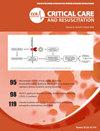在澳大利亚和新西兰的重症监护儿童中提供持续肾脏替代治疗。
IF 1.4
4区 医学
Q3 CRITICAL CARE MEDICINE
引用次数: 0
摘要
目的:本研究的目的是描述澳大利亚和新西兰重症监护病房(ICU)儿童持续肾脏替代治疗(CRRT)的当前使用、临床实践和结果。设计:回顾性、基于两国注册的队列研究和临床实践的电子调查。环境:为澳大利亚和新西兰儿科重症监护登记处做出贡献的icu,以及2021年11月进行的一项调查,包括为儿童提供CRRT的儿科重症监护培训认可的icu,都是本研究的一部分。受试者:老年患者干预措施:无。结果:58,736例ICU入院患者中有1378例(2.4%)接受了RRT (CRRT或腹膜透析[PD]),其中592例(1.0%)接受了CRRT。接受CRRT的患者年龄较大,中位年龄为43个月(四分位数范围:7-130个月),而PD为0.3个月(四分位数范围:0.1-2.6个月)。CRRT在所有患者组(523/626,84%)中更常用,但先天性心脏病(CHD)患者除外。在5年期间,接受CRRT的入学人数在1至160个单位之间变化。CRRT的ICU总死亡率为30%(175/592)。ICU死亡率最高的是新生儿([51/108]47%)和冠心病患者([40/69]58%)。CRRT的ICU死亡率在5年研究期间下降(35%-22%,p = 0.025)。调查显示各单位使用CRRT设备的一致性,但在透析方式和抗凝方案的选择上存在差异。结论:在年龄较小的儿童和冠心病患者中,CRRT的使用频率低于PD。在所有其他队列中,它是RRT的主要模式。CRRT的ICU死亡率高于PD,不同年龄和诊断组的死亡率差异很大。ICU的CRRT死亡率在研究的5年中有所下降。本文章由计算机程序翻译,如有差异,请以英文原文为准。
Provision of continuous renal replacement therapy in children in intensive care in Australia and New Zealand
Objectives
The objective of this study was to describe current use, clinical practice, and outcomes of continuous renal replacement therapy (CRRT) in children in the intensive care unit (ICU) in Australia and New Zealand.
Design
retrospective, binational registry-based cohort study and electronic survey of clinical practice.
Setting
ICUs that contribute to the Australian and New Zealand Paediatric Intensive Care Registry and a survey conducted in November 2021 including ICUs accredited for paediatric intensive care training that provide CRRT for children were part of this study.
Participants
Patients aged <18 years who received renal replacement therapy (RRT) in the ICU were included. Analysis of Australian and New Zealand Paediatric Intensive Care Registry data encompassed admissions from 1 January 2016 to 31 December 2020.
Interventions
None.
Main outcome measures
.
Results
1378 of 58,736 (2.4%) ICU admissions received RRT (CRRT or peritoneal dialysis [PD]), of which 592 (1.0%) received CRRT. Patients receiving CRRT were older and had a median age of 43 months (interquartile range: 7–130 months) compared to 0.3 months (interquartile range: 0.1–2.6 months) for PD. CRRT was used more commonly in all patient groups (523/626, 84%), except those with congenital heart disease (CHD). The number of admissions receiving CRRT varied between units from 1 to 160 admissions for the 5-year period. Overall ICU mortality for CRRT was 30% (175/592). ICU mortality was the highest in neonates ([51/108] 47%) and in those with CHD ([40/69] 58%). ICU mortality for CRRT decreased over the 5-year study period (35%–22%, p = 0.025). The survey showed consistency in CRRT equipment used between units, but there were differences in choice of dialytic modality and anticoagulation regimen.
Conclusion
CRRT is used less frequently than PD in smaller children and in those with CHD. In all other cohorts, it is the predominant mode of RRT. ICU mortality rates were higher for CRRT than for PD, with a large variation in mortality rates across age and diagnostic groups. The CRRT mortality in ICU decreased over the 5 years of the study.
求助全文
通过发布文献求助,成功后即可免费获取论文全文。
去求助
来源期刊

Critical Care and Resuscitation
CRITICAL CARE MEDICINE-
CiteScore
7.70
自引率
3.40%
发文量
44
审稿时长
>12 weeks
期刊介绍:
ritical Care and Resuscitation (CC&R) is the official scientific journal of the College of Intensive Care Medicine (CICM). The Journal is a quarterly publication (ISSN 1441-2772) with original articles of scientific and clinical interest in the specialities of Critical Care, Intensive Care, Anaesthesia, Emergency Medicine and related disciplines.
The Journal is received by all Fellows and trainees, along with an increasing number of subscribers from around the world.
The CC&R Journal currently has an impact factor of 3.3, placing it in 8th position in world critical care journals and in first position in the world outside the USA and Europe.
 求助内容:
求助内容: 应助结果提醒方式:
应助结果提醒方式:


